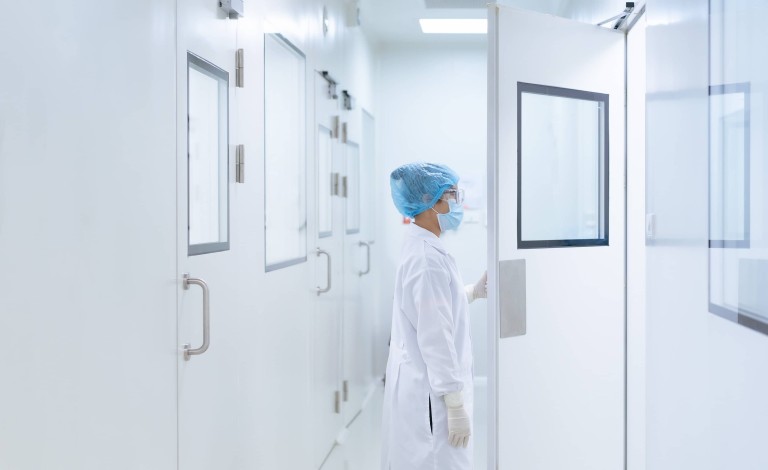
Why Proper Cleanroom Cleaning Is Crucial to Your Success
When you operate a cleanroom, it's imperative to maintain strict standards of cleanliness in the facility at all times. Whether you work in healthcare, biotechnology, pharmaceuticals, aerospace, or any other setting where cleanrooms are employed, a rigorous cleaning protocol is vital.
Accordingly, cleanroom operators follow industry “best practice” procedures to ensure that they get the results necessary for compliance with the array of cleanroom cleanliness requirements that must be consistently met. Failure to correctly sanitize your cleanroom could result in mandatory product recalls and shutting down your facility until you can bring it back into compliance.
Cleanliness specifications come to us through a variety of organizations with one of the most widely used being the International Organization for Standardization (ISO). There are 9 ISO cleanliness classes for cleanrooms ranging from ISO Class 1 to Class 9, with Class 1 being the most stringent and Class 9 being the least stringent.
For example, an ISO Class 7 cleanroom must result in no more than 352,000 particles of 0.5 micron size or larger per cubic meter of air. Requirements can vary greatly from ISO class to class, but in addition to the engineering controls used to control contamination, there are general cleanroom cleaning procedures that must also be implemented.
How You Should Develop and Implement a Cleaning Procedure
- Preparation
- Gather Supplies: Before starting, assemble all necessary cleaning supplies. This typically includes:
- Cleanroom-grade cleaning agents (approved for your specific environment)
- Disposable mop heads and wipes
- Cleanroom-compatible vacuum cleaners with HEPA filters
- Cleanroom clothing (gowns, gloves, masks, shoe covers)
- Microfiber cloths
- Buckets and wringers (cleanroom-grade if possible)
- Review Protocols: Ensure you're familiar with the cleanroom's cleaning protocols and procedures. These may vary depending on the class of cleanroom and the specific requirements of your facility.
- Personal Preparation: Wear appropriate cleanroom attire, including gown, gloves, mask, and shoe covers. Ensure your attire is free of any contaminants.
- Gather Supplies: Before starting, assemble all necessary cleaning supplies. This typically includes:
- Initial Cleaning
- Remove Debris: Begin by removing any visible debris or items from the cleanroom. This includes tools, equipment, and any waste materials.
- Dusting: Use a cleanroom-compatible vacuum cleaner to remove dust and particulates from surfaces. Start from the highest point, such as ceiling fixtures, and work your way down to avoid redistributing dust.
- Clean Surfaces: Using a cleanroom-approved disinfectant, wipe down all surfaces. This includes walls, floors, countertops, and equipment. Use a clean microfiber cloth or disposable wipe to ensure thorough cleaning. Follow the manufacturer's instructions for contact time to ensure effective disinfection.
- Floor Cleaning
- Dry Mopping: Begin with a dry mop to pick up any loose dust and particles. Ensure that the mop head is clean and free of contaminants.
- Wet Mopping: Prepare a cleaning solution according to the cleanroom's specifications. Use a clean mop and bucket to apply the solution to the floor. Start from the farthest corner of the room and work your way toward the exit to avoid walking over freshly cleaned areas.
- Rinsing and Drying: If required, rinse the floor with a clean, fresh solution to remove any residue. Allow the floor to dry completely before allowing personnel back into the cleanroom.
- Equipment and Tool Cleaning
- Disassemble Equipment: If applicable, disassemble equipment to clean each component thoroughly. Follow manufacturer guidelines for cleaning and reassembly.
- Clean and Disinfect: Wipe down all equipment and tools with cleanroom-approved disinfectants. Pay special attention to areas that come into direct contact with products or materials.
- Reassemble and Inspect: Reassemble any disassembled equipment and ensure it is functioning properly. Inspect all tools and equipment to ensure they are clean and in good working condition.
- Final Steps
- Inspect the Cleanroom: Conduct a final inspection to ensure that all areas have been cleaned to the required standard. Check for any missed spots or residues.
- Document the Cleaning: Record the cleaning activities, including date, time, personnel involved, and any issues encountered. This documentation is crucial for maintaining compliance and for future reference.
- Replenish Supplies: Check and restock any cleaning supplies that were used during the cleaning process. Ensure that all supplies are stored in a clean and organized manner.
- Allow for Settling Time: If your cleanroom requires any settling time before use, allow the appropriate period for the environment to stabilize. This ensures that any remaining particulates or residues are minimized.
- Regular Maintenance
- Establish a Schedule: Create a cleaning schedule based on the cleanroom's usage and contamination risk. Regular maintenance is key to ensuring the cleanroom remains in optimal condition.
- Continuous Training: Ensure that all personnel involved in cleaning are continuously trained and updated on the latest cleaning protocols and best practices.
- Regular Audits: Conduct periodic audits to assess the effectiveness of the cleaning procedures and make adjustments as necessary.
Connect With the Cleanroom Experts at Technical Safety Services
Maintaining a cleanroom requires a meticulous approach to cleaning and a commitment to following established protocols. By adhering to these step-by-step instructions, you can help ensure that your cleanroom remains a controlled environment where contamination risks are minimized. Regular cleaning, thorough inspections, and diligent record-keeping are essential components of a successful cleanroom maintenance program.
At Technical Safety Services, we know how important it is for cleanroom operators to follow current best practices to keep their facilities in compliance with cleanliness specifications. We have years of experience with cleanroom testing and meeting certification standards to help facilities maintain compliance.
If you're in doubt about your current cleanroom cleaning procedures, we're ready to consult. To learn more about our approach to cleanroom testing, please connect with us today.

